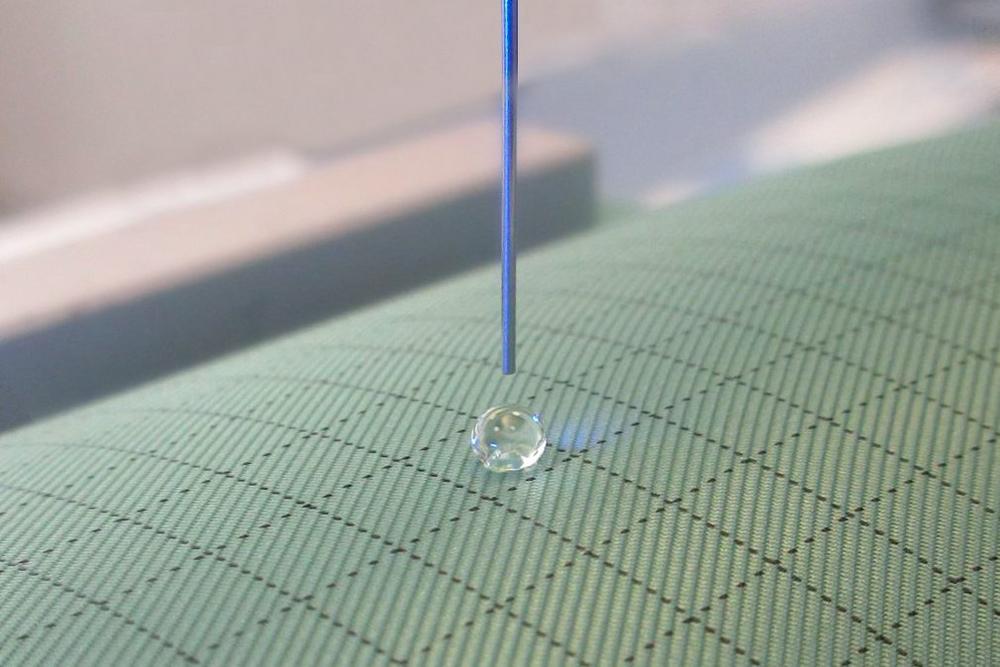The materials studied as part of a research collaboration showed very good liquid-repellent properties, as required to shield infectious droplets. The contact angle method, which was the focus of the study, proved to be valid and can potentially be used as an easily accessible method for testing medical protective clothing. In addition to the Hamburg-based measuring equipment manufacturer KRÜSS, the study involved Dastex Reinraumzubehör (engl. Cleanroom accessories) GmbH & Co. KG, and OHB System AG, which played a key role in initiating the study.
How cleanroom coveralls become droplet-repellent protective clothing
The textiles under investigation are actually used for cleanroom clothing in satellite manufacturing, where they primarily protect the environment. For potential medical use, the fabrics were given a hydrophobic PTFE coating. This modification ideally prevents wetting by infectious droplets and their absorption so that they fall off or evaporate on the surface. The detection of such hydrophobic properties is a typical issue in contact angle measurement technology, in which KRÜSS specializes.
Practical wetting tests prove good hydrophobic properties
First, the fabric was certified to have excellent liquid-repellent behavior on the basis of larger water droplets. To further investigate the protection in contact with coughing or sneezing patients, tiny droplets were applied to the materials at high speed. Microscopy-based contact angle measurements also demonstrated a good protective effect for this situation, which could even be verified on the basis of individual fibers. Reuse was also shown to be feasible. After 120 washing cycles, no impairment of the water-repellent material properties could be detected.
Contact angle measurement as a valid test method for protective clothing
Until now, the protective effect of medical clothing could only be determined in specialized laboratories. In contrast, coated textiles for other uses are often tested using improvised methods that are hardly scientifically adequate. Contact angle measurements, on the other hand, are not only valid for characterizing hydrophobic textiles, but can also be carried out quickly, easily and on a mobile basis.
In parallel, scientists at Helmholtz Zentrum Geesthacht at DESY, together with quality analysis (Nürtingen) and Volume Graphics (Heidelberg), have visualized the round shapes of non-wetting droplets in high-resolution computed tomographic studies.
There is still a long way to go before medical facilities can switch to reusable protective clothing. But it is certainly worthwhile, not only for ecological reasons and in the event of supply bottlenecks. Doctors and nurses could benefit from more comfortable and breathable protective clothing.
Results of the study will be presented online by Dr. Thomas Willers of KRÜSS at the World Congress on Textile Coating on February 18, 2021. A medical publication is initially planned in the Norwegian magazine Dagens Medisin.
Advancing your Surface Science. As specialists in interfacial chemistry and the world’s leading supplier of measuring instruments for surface and interfacial tension, we not only provide high quality product solutions – our offer is a combination of technology and scientific consulting. These include seminars and technical service as well as our Applications & Science Center for trainings and professional measurement services. Our exclusive distribution network and our locations in Hamburg (Germany), China, the US, Great Britain and France allow us to provide fast, flexible support for R&D labs and in quality control throughout the world. Our expertise, precision and passion have already convinced many prestigious companies in countless industries.
KRÜSS GmbH
Borsteler Chaussee 85
22453 Hamburg
Telefon: +49 (40) 514401-0
Telefax: +49 (40) 514401-98
https://www.kruss-scientific.com
![]()

